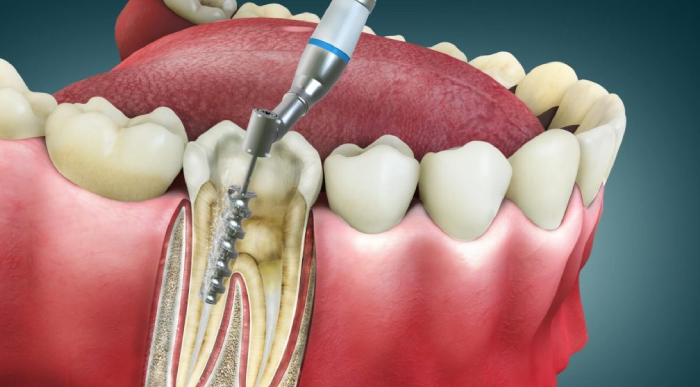About Root Canal Therapy
Root canal therapy is a dental treatment aimed at saving a tooth that has become severely infected or damaged. This procedure addresses issues within the tooth’s pulp—the soft tissue containing nerves, blood vessels, and connective tissue. When the pulp becomes infected due to deep decay, trauma, or other causes, it can lead to significant pain, swelling, and the potential loss of the tooth.
Symptoms of Root Canal Therapy
- Severe Tooth Pain
- Prolonged Sensitivity
- Swollen or Tender Gums
- Discoloration of the Tooth
- Abscess or Pimple on the Gums
- Pain When Chewing
- Foul Odor or Bad Breath
- Loose Tooth
- Swelling of the Face
- Chronic Mouth Sores

Causes of root canal therapy
- Decay: Prolonged exposure to sugary or acidic foods and poor oral hygiene can lead to significant tooth decay, which may reach the pulp and cause infection.
- Repeated Dental Procedures: Multiple procedures on the same tooth can weaken the pulp, leading to inflammation or infection.
- Cracked or Chipped Tooth: Trauma or damage to a tooth, such as a crack or chip, can expose the pulp to bacteria, resulting in infection.
- Trauma or Injury: An injury or impact to the tooth, such as from a sports accident or fall, can damage the pulp even if there are no visible cracks or chips.
- Advanced Gum Disease: Severe gum disease (periodontitis) can lead to pulp exposure if it causes significant bone loss around the tooth.
- Pulpitis: Inflammation of the pulp, often due to untreated decay or trauma, can lead to pulp infection and necessitate a root canal.
- Persistent Pain or Sensitivity: Prolonged pain or sensitivity that does not resolve with over-the-counter treatments can be a sign of pulp damage requiring root canal therapy.

Our root canal therapy treatment options:
- Traditional Root Canal Therapy
This procedure involves removing the infected or damaged pulp from inside the tooth, cleaning and disinfecting the interior, and then filling it with a biocompatible material. A crown is often placed on the tooth afterward to restore its strength and function. This approach is suitable for most cases of pulp infection or damage. - Retreatment
In some instances, a tooth that has previously undergone a root canal may become re-infected or develop new issues. Retreatment involves reopening the tooth, removing the old filling material, cleaning and disinfecting the root canals, and then refilling and sealing the tooth. A new crown or filling may be applied to restore the tooth. - Single-Visit Root Canal Therapy
For certain cases, we offer single-visit root canal therapy, where the entire procedure is completed in one appointment. This option can be convenient and efficient, especially for straightforward cases of pulp infection. It typically involves cleaning, disinfecting, and sealing the tooth in one visit, with the final restoration (like a crown) placed in a subsequent visit.
When you need
root canal therapy



Persistent Tooth Pain:
- Severe, Ongoing Pain: If you experience severe, throbbing, or persistent tooth pain that doesn’t go away, especially when biting or applying pressure, it could be a sign of damaged or infected pulp.
- Pain That Radiates: Pain from an infected tooth may radiate to other areas of your face, jaw, or ear, indicating the need for treatment.
Tooth Sensitivity:
- Prolonged Sensitivity to Hot or Cold: If you experience prolonged sensitivity to hot or cold foods and drinks (even after they’ve been removed), it may indicate damage to the tooth’s nerves or infection within the tooth’s pulp.
- Sensitivity That Lingers: Normal sensitivity should only last a few seconds, but if it lingers for minutes or longer, it could be a sign that root canal therapy is needed.
- Prolonged Sensitivity to Hot or Cold: If you experience prolonged sensitivity to hot or cold foods and drinks (even after they’ve been removed), it may indicate damage to the tooth’s nerves or infection within the tooth’s pulp.
- Sensitivity That Lingers: Normal sensitivity should only last a few seconds, but if it lingers for minutes or longer, it could be a sign that root canal therapy is needed.
Swollen or Tender Gums:
- Gum Swelling Near the Affected Tooth: If the gums around the painful tooth are swollen, tender, or inflamed, it may indicate an infection in the tooth’s root that requires treatment.
- Pimple-Like Bump on the Gums: A small bump (dental abscess) may form on the gums near the affected tooth, which is a sign of infection. Pus may also drain from the bump, leading to an unpleasant taste in your mouth.
Frequently Asked Questions
No, root canal therapy is typically not painful. Local anesthesia is used to numb the affected tooth and surrounding area, making the procedure comfortable. Most patients experience only mild discomfort during and after the procedure, which can be managed with over-the-counter pain relievers.
A root canal procedure usually takes between one to two hours. The duration depends on the complexity of the case. Some cases may require additional appointments, especially if a crown needs to be placed.
Root canal therapy is generally safe, but as with any medical procedure, there are potential risks, including infection or complications related to the tooth’s structure. Your dentist will discuss these risks with you and take steps to minimize them.
While rare, a root canal can fail if the tooth becomes reinfected or if the original infection was not completely resolved. Regular follow-up visits and good oral hygiene help reduce the risk of complications.
24 / 7 HOURS SERVICE
